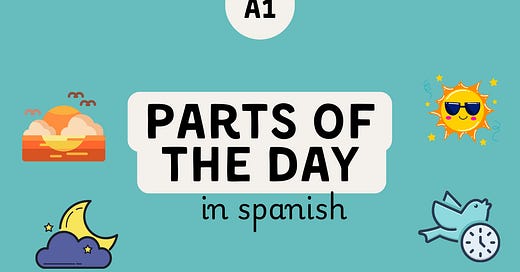The Parts of the Day in Spanish
Master Spanish time vocabulary with this guide! Learn terms like mañana, noche, crepúsculo, and aurora, plus cultural insights and grammar tips. Perfect for learners and culture lovers! 🌅🌙
Understanding how Spanish speakers divide the day is essential for both language learners and culture enthusiasts. This guide covers everything from everyday terms like mañana and noche to the poetic beauty of crepúsculo and aurora. Let’s dive in!
1. Basic Parts of the Day
La Mañana (Morning)
Timeframe: Sunrise to noon (around 12:00 PM).
Usage:
Greet with ¡Buenos días! (Good morning).
Example: Estudio por la mañana (I study in the morning).
Cultural Note: Breakfast (el desayuno) varies regionally—think café con leche in Spain or tamales in Mexico.
El Mediodía (Noon)
Timeframe: Exactly 12:00 PM.
Usage:
Al mediodía, como con mi familia (At noon, I eat with my family).
In Spain, lunch (la comida) starts around 2 PM and is the largest meal.
La Tarde (Afternoon/Evening)
Timeframe: After noon until sunset (roughly 12:00 PM–8:00 PM).
Usage:
Switch to ¡Buenas tardes! (Good afternoon).
Example: Tomamos café por la tarde (We drink coffee in the afternoon).
Cultural Note: Enjoy la merienda (a snack) in Latin America around 5 PM.
La Noche (Night)
Timeframe: Sunset to midnight.
Usage:
Greet with ¡Buenas noches! (Good evening/night).
Example: Cenamos a las 9 de la noche (We dine at 9 PM).
Cultural Note: Spaniards famously dine late, often after 9 PM!
La Madrugada (Early Morning)
Timeframe: Midnight to sunrise (12:00 AM–6:00 AM).
Usage:
Example: Trabajo hasta la madrugada (I work until dawn).
Use buenas noches for greetings during these hours.
2. Poetic and Nuanced Terms
El Crepúsculo (Twilight)
Meaning: The soft light before sunrise (crepúsculo matutino) or after sunset (crepúsculo vespertino).
Usage:
Caminamos durante el crepúsculo (We walk during twilight).
Literary gem: Pablo Neruda’s “El crepúsculo deshoja sus violetas sobre el río” (Twilight sheds its violets over the river).
Cultural Note: A time for reflection or romance in many cultures.
La Aurora (Dawn)
Meaning: The first light of day, symbolizing new beginnings.
Usage:
La aurora tiñe el cielo de rosa (Dawn tints the sky pink).
Phrase: “al romper el alba” (at the break of dawn).
Cultural Note: Mexico’s La Aurora brand ties the word to artistry.
El Aura (Aura/Breeze)
Dual Meanings:
Spiritual: An energy field around a person (Tiene un aura positiva).
Nature: In the Caribbean, a light breeze (Sentí un aura fresca).
Fun Fact: Carlos Fuentes’ novel Aura explores mystery through this metaphor.
3. Grammar Tips
Prepositions: Use por la (general time) or en la (specific moments):
Por la mañana (in the morning) vs. En la noche de ayer (last night).
Greetings: Match to the time:
Buenos días (morning) → Buenas tardes (afternoon) → Buenas noches (night).
4. Cultural Nuances
Regional Variations:
In Argentina, la tarde may stretch until 8 PM.
In Spain, la noche starts earlier in winter.
Traditions:
La siesta (afternoon nap) in Spain and Latin America.
La cena (dinner) as a social event in Spain.
5. Why These Words Matter
Daily Life: Essential for scheduling and social interactions.
Literature & Art: Terms like crepúsculo and aurora enrich poetry and prose.
Spiritual Depth: Words like aura reflect cultural blends of indigenous and European influences.
6. Practice Time!
Describe your routine: Me levanto al amanecer y leo hasta el mediodía.
Use poetic terms: El crepúsculo vespertino en Sevilla es mágico.
Practice spelling the parts of the day in Spanish
Click here to access
🚀 Want to Learn More?
📅 Book a 1-on-1 Spanish Lesson with me! 👉 Click here to schedule!






